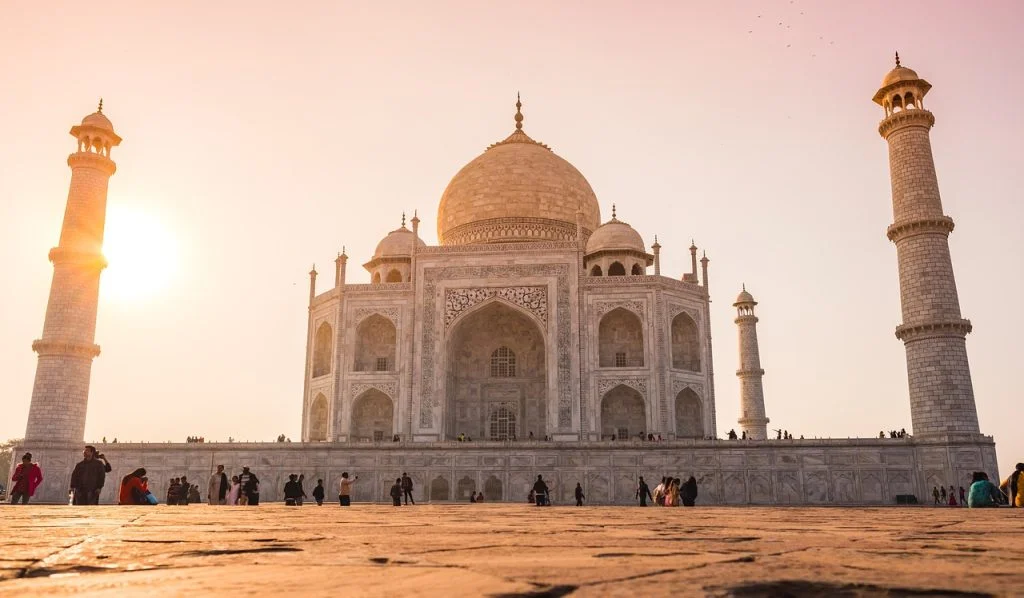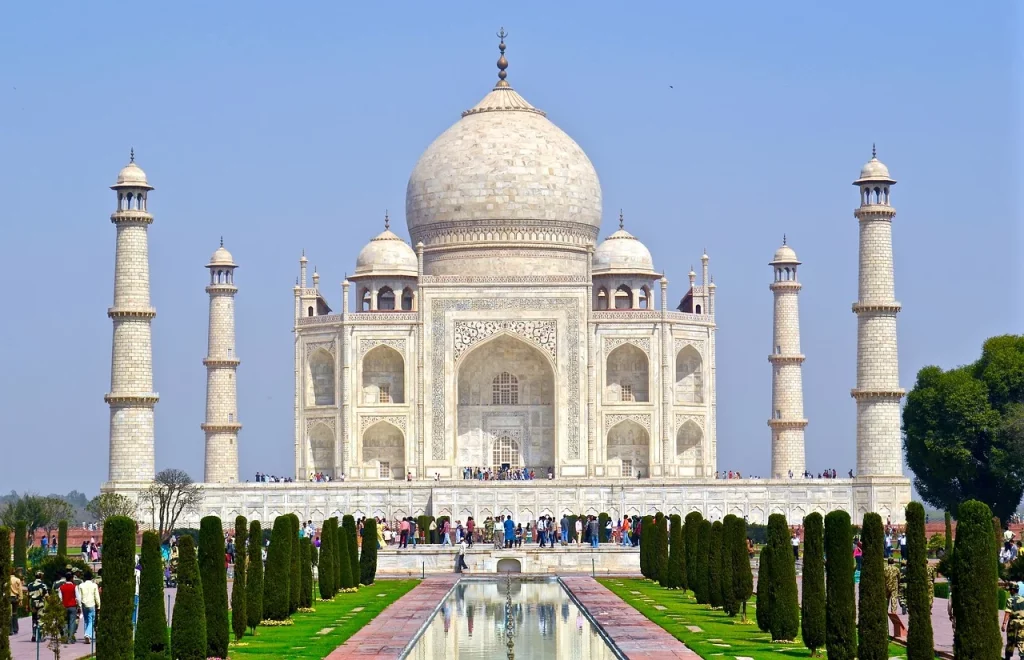Have you ever marveled at the majestic beauty of the Taj Mahal? This iconic symbol of love, located in Agra, India, is not just a breathtaking architectural masterpiece; it’s a story etched in marble.
In this article, I will share with you some fascinating facts about the Taj Mahal, each one revealing a layer of history, art, and emotion. From its intricate designs to the love story that inspired it, get ready to embark on a journey through time and discover the wonders of this world-famous monument.
The Taj Mahal rises above the banks of the river like a solitary tear suspended on the cheek of time.
Rabindranath Tagore
Taj Mahal Facts
Dive into the depths of the Taj Mahal’s history and secrets, but remember, I created a quiz at the end that will challenge how well you’ve grasped these facts. Read carefully and don’t disappoint me.
- The Taj Mahal is located in Agra, Uttar Pradesh, India.
- It was commissioned in 1632 by the Mughal emperor Shah Jahan.
- The mausoleum commemorates Shah Jahan’s favorite wife, Mumtaz Mahal.
- Mumtaz Mahal died giving birth to their 14th child in 1631.
- The Taj Mahal combines elements of Islamic, Persian, Ottoman Turkish, and Indian architectural styles.
- It’s considered a masterpiece of Mughal architecture.
- Ustad Ahmad Lahauri is generally considered to be the principal designer.
- The Taj Mahal was designated as a UNESCO World Heritage Site in 1983.
- It is renowned for its symmetrical beauty and aesthetic qualities.
- The complex includes a main gateway, garden, mosque, jawab, and the mausoleum.
- Approximately 20,000 artisans were involved in its construction.
- The structure is made of white marble inlaid with semi-precious stones.
- Calligraphy of Quranic verses adorns many parts of the mausoleum.

- The marble dome measures about 35 meters (115 ft) high.
- Four minarets frame the tomb at each corner.
- The complex spans approximately 17 hectares (42 acres).
- It took around 20 years to complete the Taj Mahal.
- The main mausoleum was completed in 1643.
- Additional structures and the garden were completed five years later.
- Yamuna River flows alongside the Taj Mahal complex.
- The changing colors of the marble at different times of the day symbolize the changing mood of a woman.
- During the Indian Rebellion of 1857, some parts were defaced and damaged.
- British Viceroy Lord Curzon ordered a massive restoration project in the early 20th century.
- The Taj Mahal attracts 7–8 million visitors annually.
- A myth suggests that Shah Jahan planned to build a black marble mausoleum for himself across the river.
- Pollution has been affecting the marble’s whiteness, leading to conservation efforts.
- The site employs several measures to protect it from environmental threats.
- During World War II and the India-Pakistan wars, it was covered with scaffoldings to mislead bombers.

- The garden is laid out in the classical Mughal charbagh (four-part) style.
- Legends suggest that the artisans who worked on the Taj were forbidden to work on any similar projects.
- The Taj Mahal’s reflection in the garden’s pool is a significant aspect of its design.
- It’s considered an emblem of India’s rich history.
- The interior chamber houses the false sarcophagi of Mumtaz Mahal and Shah Jahan; the real graves are at a lower level.
- Annual maintenance and restoration work continue to be a priority.
- It was inscribed on the list of the New Seven Wonders of the World in 2007.
- The complex employs strict security measures to protect it.
- Photography inside the mausoleum is prohibited.
- On certain days, the Taj Mahal is closed to tourists in the morning due to religious reasons.

- The color of the marble appears to change at sunrise, sunset, and under the moonlight.
- It’s a popular symbol in literature and media as an emblem of love.
- Myths and legends about the Taj Mahal contribute to its mystique and appeal.
- It has inspired numerous replica buildings worldwide.
- Its inclusion in numerous lists of top architectural wonders underscores its global significance.
- Every year, special events and light shows are organized to showcase its beauty.
- The site implements measures to manage the large influx of tourists.
- Its architectural precision includes the slightly inclined minarets for balance and symmetry.
- Economic impact on Agra is significant, due to tourism.
- It has survived threats from natural disasters, such as floods and storms.
- The site has been a subject of scholarly studies in architecture, history, and cultural studies.
- It remains a powerful symbol of India’s rich cultural and historical heritage.
Taj Mahal Myths

I hope you enjoyed all these facts, because now it’s time to separate the truth from the myth. Let’s shine light on some popular myths about Taj Mahal.
- The Taj Mahal was built by a single ruler as a symbol of love
While it’s true that Emperor Shah Jahan commissioned the Taj Mahal in memory of his wife Mumtaz Mahal, it was not a solo effort. The construction involved thousands of artisans and craftsmen from across the region, and it was a significant architectural and logistical feat of its time. - The Taj Mahal is an entirely Islamic monument
The Taj Mahal, while predominantly Islamic in design, actually incorporates elements from Persian, Indian, and Islamic architectural styles. This blend reflects the diverse cultural influences present in India during the Mughal era. - The workers who built the Taj Mahal had their hands cut off
This is a popular, but unfounded, myth. There’s no historical evidence to support the claim that Shah Jahan ordered the amputation of the workers’ hands to prevent them from building another monument of its kind. - The Taj Mahal was originally a Hindu temple
There is no credible evidence to support this claim. The Taj Mahal was designed and built as a mausoleum for Mumtaz Mahal. Historical documents and architectural studies consistently affirm its origin as a Mughal-era Islamic mausoleum. - The Taj Mahal is turning yellow due to pollution
While it’s true that pollution has affected the Taj Mahal, causing discoloration, the Archaeological Survey of India has undertaken several restoration and cleaning projects to address this. The change in color is also partly due to natural weathering of its marble structure over time.
No products found.
Taj Mahal Quotes

Let’s move on with my list of favorite quotes. Let me know which one is your favorite, and if you have a quote to share, you can write it in the comments so I can add it to the list.
The Taj Mahal is a tear drop on the cheek of eternity.
Pandit Jawaharlal Nehru
Nehru portrays the Taj Mahal as an eternal symbol of grief, reflecting its creation as a monument of love and loss.
The world is divided into two categories: those who have seen the Taj Mahal and love it and those who have not seen the Taj and love it.
Bill Clinton
Clinton emphasizes the universal admiration for the Taj Mahal, regardless of whether one has seen it in person or not.
Marble, I perceive, covers a multitude of sins.
Aldous Huxley
Huxley humorously comments on the lavish use of marble in the Taj Mahal, perhaps alluding to the extravagance involved in its construction.
Taj Mahal! White Pearl! Let it be a tear-drop on the face of eternity!
Edward Lear
Lear passionately exclaims his admiration for the Taj Mahal, likening it to a precious pearl and a symbol of eternal sorrow.
The world is divided into two kinds of people: those who have seen the Taj Mahal, and those who have not.
Mark Twain
Twain humorously categorizes people based on their experience with the Taj Mahal, underscoring its significance as a must-see monument.
Taj Mahal FAQ

Before you dive into the quiz, let’s navigate the FAQs. This section is your last chance to grasp essential knowledge about the Taj Mahal, so you can prove your mastery!
- Why is the Taj Mahal famous?
The Taj Mahal is renowned globally for its stunning architectural beauty and historical significance. It’s a symbol of love, built by the Mughal Emperor Shah Jahan in memory of his beloved wife, Mumtaz Mahal. This magnificent structure is admired for its intricate carvings, detailed calligraphy, and the striking white marble it’s built from, reflecting different hues depending on the sunlight. - Is the Taj Mahal a wonder of the world?
Yes, the Taj Mahal is considered one of the New Seven Wonders of the World. This recognition was officially bestowed in 2007, highlighting its status as a masterpiece of architectural art and a testament to the rich history and cultural heritage of India. - When was the Taj Mahal built?
Construction of the Taj Mahal began around 1632 and was largely completed in 1643, although work on other phases of the project continued for approximately 10 more years. The construction involved thousands of artisans and craftsmen, making it a significant historical feat. - Is the Taj Mahal a tomb?
Yes, the Taj Mahal is essentially a tomb. It was built to house the tomb of Mumtaz Mahal, the wife of Emperor Shah Jahan. Later, Shah Jahan’s own tomb was also placed in it beside his wife’s, making it their final resting place. The central structure is a large, white marble mausoleum surrounded by gardens and other buildings. - What are the unique architectural features of the Taj Mahal?
It is famous for its symmetrical design, which is a hallmark of Mughal architecture. Its central dome is flanked by four smaller domes, and the four minarets at each corner of the platform add to its grandeur. The intricate inlay work with semi-precious stones and calligraphy using verses from the Quran are among its distinctive features. The complex also includes a mosque and a guest house, and it is set in formal gardens bounded on three sides by a crenellated wall.
No products found.
Taj Mahal Trivia

Welcome to the Taj Mahal Quiz! But be warned: if you don’t answer correctly, your dreams might be haunted by the ghost of an emperor searching for his lost architect!
Conclusion
The Taj Mahal stands not just as a testament to architectural brilliance but as a beacon of love’s eternal nature. It challenges us to think about the legacies we create and the emotions we immortalize.
This emblem of love transcends time and culture, reminding us of the profound human capacity for devotion and creativity. How does the story of the Taj Mahal inspire you in your life? Let me know in the comments.
14 Sources Used For This ArticleThe Taj Mahal Hindi – Asis Biz
Taj Mahal Tourist Guide – Holiday Travel
The Magnificent Taj Mahal – Nur Wizard
Taj Mahal – Taj Mahal Blog
Taj Mahal History – Blog
10 Interesting Facts About Taj Mahal – Wonders List
Taj Mahal: The Pinnacle of Mughal Architecture – Indiator
Taj Mahal, The White Pearl Of India – Striker Blog
Taj Mahal: 7 Things You Must Know Before Visiting – Local Adventures
The Taj Mahal – Valyrian Guy
Taj Mahal – San Deep Blog
The Taj Mahal: Unveiling the Story – North Of Known
15 Interesting Facts about the Taj Mahal – Asian Highlights


